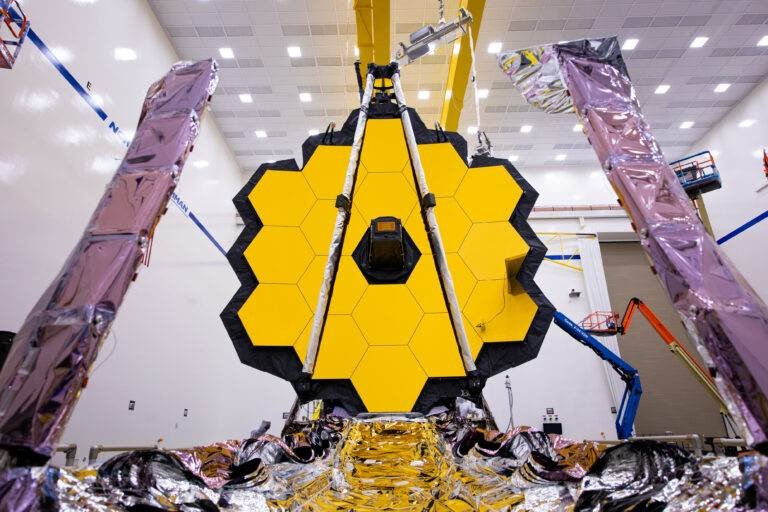Scheduled for launch in October 2021, the James Webb Telescope is designed to complement and extend the famous Hubble Space Telescope’s life, which has been in constant use since snapping its first pictures in May 1990.
Studies already slated for time on the observatory range from the analysis of distant galaxies and stars to much closer targets like Mars and Jupiter. All will be jointly operated by NASA and The Space Telescope Science Institute (STScI).
BACKGROUND: What is the James Webb Telescope?
Named for James E. Webb, a space program hero and the administrator of NASA from 1961 to 1968, the NASA website dedicated to the project states that “Webb will be the largest, most powerful and complex space telescope ever built and launched into space. It will fundamentally alter our understanding of the universe.”
Development began back in 1996. After navigating numerous changes by four different presidential administrations and some redesigns in 2005, the telescope’s construction was completed in late 2016. Once the 2021 launch places Webb in a stable orbit known as LaGrange Point 2, and out of the direct light of the Sun, only one final hurdle remains.
“Just the launch and deployment of Webb in space will be a great feat of engineering that I cannot wait to see,” Dr. Knicole Colon, Deputy Project Scientist for Exoplanet Science on the James Webb Space Telescope team, told The Debrief. “With a mirror that unfolds and aligns itself in space, and a tennis-court-size sunshield that deploys to protect Webb and keep it cool from the Sun’s heat, the launch and deployment of Webb will set the stage for the development of even more advanced future space telescopes.”
Once that milestone is achieved, deploying a mirror with over six times the collecting surface of Hubble’s and then extending the heat shield, the scientific studies already lined up for time on the telescope will be ready to begin.
“Webb will study planets and moons in our own Solar System, from Mars to Jupiter and beyond, in addition to asteroid(s) and comets and other small bodies in the Solar System,” Dr. Colon explained. “Webb will provide new measurements of the composition of these objects, which will further establish [for example,] the presence and abundance of water, methane, and other molecules in their atmospheres as well.”
How these pre-selected missions will accomplish such optimistic goals comes down to the instruments and hardware it will use and the scientists who will put those instruments to use.


THE HARDWARE
Along with its enormous mirror, an array of four custom made instruments, each of which has a distinct set of measuring capabilities, will be employed to gather data.
They are:
– The NIRCam (Near InfraRed Camera) was built by a team at the University of Arizona. It can observe light spectra from the edge of the visible (0.6 micrometers) through the near-infrared (5 micrometers).
– The FGS/NIRISS (Fine Guidance Sensor/Near Infrared Imager and Slitless Spectrograph) developed by the Canadian Space Agency (CSA), will help stabilize the line-of-sight of the telescope during science observations while also performing imaging and spectroscopy in the 0.8 to 5 micrometer wavelength range.
– The NIRSpec (Near InfraRed Spectrograph) built by the European Space Agency (ESA), will observe light spectra in the same wavelength as the NIRCam, also has a multi-object mode that will allow for simultaneous observations of hundreds of individual objects anywhere in its field of view.
– The MIRI, (Mid-InfraRed Instrument) developed by NASA and several European countries will observe light in the mid-to-long-infrared wavelength range of 5 to 27 micrometers. Also, because it needs to stay below an incredibly frigid 6 Kelvin, a helium gas mechanical cooler was placed on the environmental shield’s forward side.
According to Dr. Colon, “all [of these instruments] have capabilities that provide the opportunity to detect water absorption in an exoplanet’s atmosphere because they all cover near-infrared or infrared wavelengths where strong water absorption features are present.” That means unlike the Hubble telescope, which observes in the near ultraviolet, visible, and near-infrared spectra, the four Webb instruments will observe from long-wavelength visible light all the way through mid-infrared. This broad scope will allow it to observe high red-shift objects that are too old and too distant for Hubble to observe.
It is an impressive set of tools and capabilities, and all are set to be put to use by several missions already on tap, as well those still waiting to learn if they have been selected.
The Missions of The James Web Telescope
When determining which teams and projects will have access to Webb during its first year in operation, NASA and STScI came up with two main groups, the “Guaranteed Time Observations” (GTO) group and the “Early Release Sciences” (ERS) group.
Competitively selected after a peer-review process and designed to take place during the first few months of operation, the ERS programs will focus on core science issues.
As explained to The Debrief by Dr. Colon, these teams “will provide a set of benchmark data of all types of astrophysical objects (like galaxies, stars, exoplanets, and the Jupiter system) so we can establish how well Webb and its instruments are operating once it is actually in flight.”
After this set of critical observations are completed, the GTO programs go next. Also, according to Dr. Colon, these are groups “who, for example, built some of the instruments that are installed on Webb, or provided some key contribution to the development of the mission.”
Like the ERS programs, they also cover a wide range of science issues, from studies of Extrasolar Planets, Brown Dwarfs, Protostars, and Protostellar Disks, to an extremely promising subgroup of studies highlighted in a separate piece by The Debrief that will examine the atmospheres of a group of planets in the TRAPPIST-1 star system.
In total, 13 ERS missions and 120 GTO missions are already waiting to go, while a separate group of hopeful candidates is standing by, waiting to learn if they will be next. That announcement is right around the corner.
“We anticipate announcements of those selected science programs in March/April 2021,” Dr. Colon stated. “At which point we will know more about the different types of targets that Webb will observe in its first year of science operations.”
OUTLOOK
Once these studies gather their data, the various teams running the studies will have an exclusivity period of 12 months to analyze their results. But, Dr. Colon notes, “after that period, the data will be publicly available for anyone in the world to access.” Teams who didn’t qualify for the exclusive use of the Webb can benefit from the collected public data.
Whatever the results of these first tests, the decades-long wait to place the newest, most cutting edge space observatory ever built into orbit will finally be over. And after that happens, Dr. Colon says that “Webb is going to expand our knowledge at every stage – it will not only see the light from some of the first stars and galaxies ever formed in the universe but will also provide detailed global views of weather on our nearest neighbor, Mars. I am personally excited to see what discoveries Webb will make that are unexpected.”
Based upon the numerous responses The Debrief received from the teams of eager scientists waiting to take Webb’s instruments for their first real-world test drive, that same excitement appears to be growing across much of the astronomy community.

